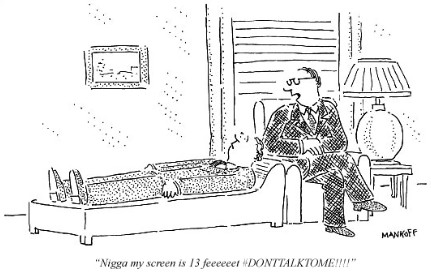Man Explains Joke To Other Man Who Claims Not to Get It

“While I really can only speak for myself — and, to an extent, for my friends Josh Cagan and Storm DiCostanzo, the other two initial developers of the meme — I would say (hopefully in a slightly more civil manner than a couple of the other commenters) that these cartoons weren’t intended to be seen out of the context of the associated hashtag. So that you couldn’t *not* know that they were Kanye West tweets — just like you couldn’t not know they were New Yorker cartoons. And as such, they’re not *intended* to be funny outside of that context/label, because the humor is entirely *based* in the context, and not in some innate “meaning” beyond the mashup itself. If any of the mashups ended up being “actually” funny outside of that context, it’s mostly by accident, at least on our part — because even the best matches between caption and image (a couple examples: http://twitpic.com/2bbn1a / http://twitpic.com/2b19sl / http://twitpic.com/2b1cci ) were still only mildly funny without the context. So we instead mostly concentrated on mashups that intentionally *didn’t* match well (the example you posted above; others like: http://twitpic.com/2b17f4 / http://twitpic.com/2b0yi2 ), the humor then being the incongruity of New Yorker cartoons’ traditional measured, aloof, wry tone and Kanye’s stream-of-consciousness, raw, unfiltered Twitter musings. The vast majority of followers of the meme on Twitter seemed to inherently understand this. Put more simply: Twitter, the hashtag, and knowledge of both Kanye’s tweets and New Yorker cartoons basically *are* “the joke” (to grossly mis-apply McLuhan, “the medium is the message”); to divorce them of that context and then accuse them of not being funny is inherently unfair.”
-Paul Sabourin, originator of the popular Kanye West Twitter/New Yorker cartoon mash-up
meme, defends his creation against accusations of humorlessness made by an actual New Yorker cartoonist. It’s the kind of Internet-only debate that makes you wish everyone, including yourself, were dead illustrates the vibrancy of this new digital culture in which we all participate.
